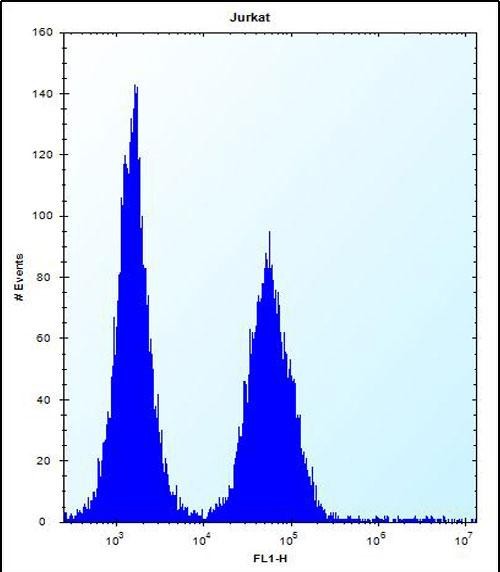ABI2 Antibody (N-term)
Affinity Purified Rabbit Polyclonal Antibody (Pab)
- SPECIFICATION
- CITATIONS
- PROTOCOLS
- BACKGROUND

Application
| FC, WB, E |
|---|---|
| Primary Accession | Q9NYB9 |
| Other Accession | P62484, NP_005750.4 |
| Reactivity | Human, Mouse |
| Host | Rabbit |
| Clonality | Polyclonal |
| Isotype | Rabbit IgG |
| Calculated MW | 55663 Da |
| Antigen Region | 1-30 aa |
| Gene ID | 10152 |
|---|---|
| Other Names | Abl interactor 2, Abelson interactor 2, Abi-2, Abl-binding protein 3, AblBP3, Arg-binding protein 1, ArgBP1, ABI2, ARGBPIA |
| Target/Specificity | This ABI2 antibody is generated from rabbits immunized with a KLH conjugated synthetic peptide between 1-30 amino acids from the N-terminal region of human ABI2. |
| Dilution | FC~~1:10~50 WB~~1:1000 E~~Use at an assay dependent concentration. |
| Format | Purified polyclonal antibody supplied in PBS with 0.09% (W/V) sodium azide. This antibody is purified through a protein A column, followed by peptide affinity purification. |
| Storage | Maintain refrigerated at 2-8°C for up to 2 weeks. For long term storage store at -20°C in small aliquots to prevent freeze-thaw cycles. |
| Precautions | ABI2 Antibody (N-term) is for research use only and not for use in diagnostic or therapeutic procedures. |
| Name | ABI2 {ECO:0000303|PubMed:28397838, ECO:0000312|HGNC:HGNC:24011} |
|---|---|
| Function | Regulator of actin cytoskeleton dynamics underlying cell motility and adhesion. Functions as a component of the WAVE complex, which activates actin nucleating machinery Arp2/3 to drive lamellipodia formation (PubMed:21107423). Acts as a regulator and substrate of nonreceptor tyrosine kinases ABL1 and ABL2 involved in processes linked to cell growth and differentiation. Positively regulates ABL1-mediated phosphorylation of ENAH, which is required for proper polymerization of nucleated actin filaments at the leading edge (PubMed:10498863, PubMed:7590236, PubMed:8649853). Contributes to the regulation of actin assembly at the tips of neuron projections. In particular, controls dendritic spine morphogenesis and may promote dendritic spine specification toward large mushroom-type spines known as repositories of memory in the brain (By similarity). In hippocampal neurons, may mediate actin-dependent BDNF-NTRK2 early endocytic trafficking that triggers dendrite outgrowth (By similarity). Participates in ocular lens morphogenesis, likely by regulating lamellipodia-driven adherens junction formation at the epithelial cell-secondary lens fiber interface (By similarity). Also required for nascent adherens junction assembly in epithelial cells (PubMed:15572692). |
| Cellular Location | Cytoplasm. Nucleus |
| Tissue Location | Widely expressed. Abundant in testes, ovary, thymus, and colon, with lower but detectable levels in prostate, peripheral blood leukocytes, and spleen. |

Thousands of laboratories across the world have published research that depended on the performance of antibodies from Abcepta to advance their research. Check out links to articles that cite our products in major peer-reviewed journals, organized by research category.
info@abcepta.com, and receive a free "I Love Antibodies" mug.
Provided below are standard protocols that you may find useful for product applications.
Background
ABI2 may act in regulation of cell growth and transformation by interacting with nonreceptor tyrosine kinases ABL1 and/or ABL2. May be involved in cytoskeletal reorganization. Regulates ABL1/c-Abl-mediated phosphorylation of MENA.
References
Ryu, J.R., et al. Mol. Cell. Biol. 29(7):1735-1748(2009)
Kano, S., et al. Cancer Res. 68(14):5572-5580(2008)
Sugiyama, N., et al. Mol. Cell Proteomics 6(6):1103-1109(2007)
Li, Y., et al. J. Cell. Sci. 120 (PT 8), 1436-1446 (2007) :
O'Donnell, C.J., et al. BMC Med. Genet. 8 SUPPL 1, S4 (2007) :
If you have used an Abcepta product and would like to share how it has performed, please click on the "Submit Review" button and provide the requested information. Our staff will examine and post your review and contact you if needed.
If you have any additional inquiries please email technical services at tech@abcepta.com.













 Foundational characteristics of cancer include proliferation, angiogenesis, migration, evasion of apoptosis, and cellular immortality. Find key markers for these cellular processes and antibodies to detect them.
Foundational characteristics of cancer include proliferation, angiogenesis, migration, evasion of apoptosis, and cellular immortality. Find key markers for these cellular processes and antibodies to detect them. The SUMOplot™ Analysis Program predicts and scores sumoylation sites in your protein. SUMOylation is a post-translational modification involved in various cellular processes, such as nuclear-cytosolic transport, transcriptional regulation, apoptosis, protein stability, response to stress, and progression through the cell cycle.
The SUMOplot™ Analysis Program predicts and scores sumoylation sites in your protein. SUMOylation is a post-translational modification involved in various cellular processes, such as nuclear-cytosolic transport, transcriptional regulation, apoptosis, protein stability, response to stress, and progression through the cell cycle. The Autophagy Receptor Motif Plotter predicts and scores autophagy receptor binding sites in your protein. Identifying proteins connected to this pathway is critical to understanding the role of autophagy in physiological as well as pathological processes such as development, differentiation, neurodegenerative diseases, stress, infection, and cancer.
The Autophagy Receptor Motif Plotter predicts and scores autophagy receptor binding sites in your protein. Identifying proteins connected to this pathway is critical to understanding the role of autophagy in physiological as well as pathological processes such as development, differentiation, neurodegenerative diseases, stress, infection, and cancer.




